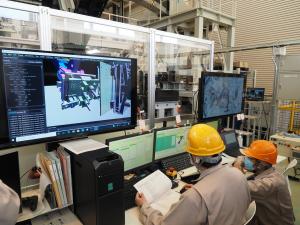Remote handling

Remote handling is required for ITER assembly tasks as well as for maintenance and upgrade tasks once nuclear operation (deuterium-tritium operation) is underway. ©ITER Japan
The ITER remote handling systems comprise a large array of robotic transporters, manipulators, tooling and support structures deployed within the ITER machine, the Tokamak Building, and the Hot Cell Facility.
The systems must operate within limited space and with low observability, handle and manipulate large and heavy components up to 45 tonnes without causing damage to the components or their surroundings, and withstand exposure to a radiation environment.
ITER’s remote handling systems are designed to assist in the assembly of the ITER machine and then play an important role during the maintenance phases. Once operation begins, it will be impossible to make changes, conduct inspections, or repair any of the tokamak components in the activated areas other than by remote handling.
Four major remote handling systems are planned for ITER:
- The blanket remote handling system transports the blanket first wall panels or the blanket shield blocks into or out of the vacuum vessel.
- The divertor remote handling system is used to install, maintain and replace divertor assemblies in the vacuum vessel.
- The neutral beam remote handling system provides a means for the maintenance within the neutral beam area of the Tokamak Building of the neutral beam plant equipment.
- The cask and plug remote handling system takes care of the transfer of components between the machine and the Hot Cell Complex for refurbishment/repair/replacement.
A separate remote handling system is also planned for deployment within the ITER Hot Cell Facility. Operators on the ITER site in charge of remote handling operations will work either from the remote handling control room for operations in and around the machine, or from a control room inside the ITER Hot Cell Facility.
Reliable and robust remote handling systems are critical to the success of ITER and to future fusion reactors.
